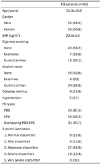1. Tack J, Talley NJ, Camilleri M, et al. Functional gastroduodenal disorders. Gastroenterology. 2006; 130:1466–1479.

2. Stanghellini V, Chan FK, Hasler WL, et al. Gastroduodenal disorders. Gastroenterology. 2016; 150:1380–1392.

3. Mahadeva S, Goh KL. Epidemiology of functional dyspepsia: a global perspective. World J Gastroenterol. 2006; 12:2661–2666.

4. Jung HK, Keum BR, Jo YJ, et al. Diagnosis of functional dyspepsia: a systematic review. Korean J Gastroenterol. 2010; 55:296–307.

5. Kim SE, Park HK, Kim N, et al. Prevalence and risk factors of functional dyspepsia: a nationwide multicenter prospective study in Korea. J Clin Gastroenterol. 2014; 48:e12–e18.
6. Jin X, Li YM. Systematic review and meta-analysis from Chinese literature: the association between Helicobacter pylori eradication and improvement of functional dyspepsia. Helicobacter. 2007; 12:541–546.

7. Armstrong D. Helicobacter pylori infection and dyspepsia. Scand J Gastroenterol Suppl. 1996; 215:38–47.
8. Du LJ, Chen BR, Kim JJ, Kim S, Shen JH, Dai N. Helicobacter pylori eradication therapy for functional dyspepsia: systematic review and meta-analysis. World J Gastroenterol. 2016; 22:3486–3495.
9. Jodaki A, Sahraie A, Yasemi M, Peyman H, Yasemi MR, Hemati K. Helicobacter pylori eradication effect on patients with functional dyspepsia symptoms. Minerva Gastroenterol Dietol. 2016; 62:148–154.
10. Talley NJ, Locke GR, Saito YA, et al. Effect of amitriptyline and escitalopram on functional dyspepsia: a multicenter, randomized controlled study. Gastroenterology. 2015; 149:340.e2–349.e2.

11. Kim SE, Park YS, Kim N, et al. Effect of Helicobacter pylori eradication on functional dyspepsia. J Neurogastroenterol Motil. 2013; 19:233–243.
12. Holtmann G, Kutscher SU, Haag S, et al. Clinical presentation and personality factors are predictors of the response to treatment in patients with functional dyspepsia; a randomized, double-blind placebo-controlled crossover study. Dig Dis Sci. 2004; 49:672–679.

13. Lee JY, Kim N, Park KS, et al. Comparison of sequential therapy and amoxicillin/tetracycline containing bismuth quadruple therapy for the first-line eradication of Helicobacter pylori: a prospective, multi-center, randomized clinical trial. BMC Gastroenterol. 2016; 16:79.

14. Song KH, Jung HK, Min BH, et al. Development and validation of the Korean Rome III questionnaire for diagnosis of functional gastrointestinal disorders. J Neurogastroenterol Motil. 2013; 19:509–515.

15. Hong SJ, Sung IK, Kim JG, et al. Failure of a randomized, double-blind, placebo-controlled study to evaluate the efficacy of H. pylori eradication in H. pylori-infected patients with functional dyspepsia. Gut Liver. 2011; 5:468–471.

16. El-Serag HB, Talley NJ. Systemic review: the prevalence and clinical course of functional dyspepsia. Aliment Pharmacol Ther. 2004; 19:643–654.
17. Lacy BE, Talley NJ, Locke GR 3rd, et al. Review article: current treatment options and management of functional dyspepsia. Aliment Pharmacol Ther. 2012; 36:3–15.

18. Miwa H, Ghoshal UC, Fock KM, et al. Asian consensus report on functional dyspepsia. J Gastroenterol Hepatol. 2012; 27:626–641.

19. Nan J, Zhang L, Zhu F, et al. Topological alterations of the intrinsic brain network in patients with functional dyspepsia. J Neurogastroenterol Motil. 2016; 22:118–128.

20. Choi YJ, Kim N, Kim J, Lee DH, Park JH, Jung HC. Upregulation of vanilloid receptor-1 in functional dyspepsia with or without Helicobacter pylori infection. Medicine (Baltimore). 2016; 95:e3410.

21. Yamawaki H, Futagami S, Shimpuku M, et al. Leu72Met408 polymorphism of the ghrelin gene is associated with early phase of gastric emptying in the patients with functional dyspepsia in Japan. J Neurogastroenterol Motil. 2015; 21:93–102.

22. Sugano K, Tack J, Kuipers EJ, et al. Kyoto global consensus report on Helicobacter pylori gastritis. Gut. 2015; 64:1353–1367.
23. Massarrat S. Unacceptability of Kyoto global consensus report on Helicobacter pylori gastritis. Arch Iran Med. 2016; 19:527–528.
24. Chen Q, Lu H. Kyoto global consensus report on Helicobacter pylori gastritis and its impact on Chinese clinical practice. J Dig Dis. 2016; 17:353–356.
25. Zhao B, Zhao J, Cheng WF, et al. Efficacy of Helicobacter pylori eradication therapy on functional dyspepsia: a meta-analysis of randomized controlled studies with 12-month follow-up. J Clin Gastroenterol. 2014; 48:241–247.
26. Kim YJ, Chung WC, Kim BW, et al. Is Helicobacter pylori associated functional dyspepsia correlated with dysbiosis? J Neurogastroenterol Motil. 2017; 23:504–516.
27. Ang TL, Fock KM, Teo EK, et al. Helicobacter pylori eradication versus prokinetics in the treatment of functional dyspepsia: a randomized, double-blind study. J Gastroenterol. 2006; 41:647–653.

28. Kawakubo H, Tanaka Y, Tsuruoka N, et al. Upper gastrointestinal symptoms are more frequent in female than male young healthy Japanese volunteers as evaluated by questionnaire. J Neurogastroenterol Motil. 2016; 22:248–253.

29. Lorena SL, Tinois E, Brunetto SQ, Camargo EE, Mesquita MA. Gastric emptying and intragastric distribution of a solid meal in functional dyspepsia: influence of gender and anxiety. J Clin Gastroenterol. 2004; 38:230–236.
30. Winthorst WH, Post WJ, Meesters Y, Penninx BW, Nolen WA. Seasonality in depressive and anxiety symptoms among primary care patients and in patients with depressive and anxiety disorders; results from the Netherlands study of depression and anxiety. BMC Psychiatry. 2011; 11:198.

31. Kim YS, Kim N, Kim GH. Sex and gender differences in gastroesophageal reflux disease. J Neurogastroenterol Motil. 2016; 22:575–588.

32. Choi YJ, Park YS, Kim N, et al. Gender differences in ghrelin, nociception genes, psychological factors and quality of life in functional dyspepsia. World J Gastroenterol. 2017; 23:8053–8061.

33. Lacy BE, Yu J, Crowell MD. Medication risk-taking behavior in functional dyspepsia patients. Clin Transl Gastroenterol. 2015; 6:e69.

34. Hsu YC, Liou JM, Liao SC, et al. Psychopathology and personality trait in subgroups of functional dyspepsia based on Rome III criteria. Am J Gastroenterol. 2009; 104:2534–2542.

35. Park B, Kim J. Oral contraceptive use, micronutrient deficiency, and obesity among premenopausal females in Korea: the necessity of dietary supplements and food intake improvement. PLoS One. 2016; 11:e0158177.

36. Hwang JJ, Lee DH, Lee AR, et al. Efficacy of 14-d vs 7-d moxifloxacin-based triple regimens for second-line Helicobacter pylori eradication. World J Gastroenterol. 2015; 21:5568–5574.
37. Lee BH, Kim N, Hwang TJ, et al. Bismuth-containing quadruple therapy as second-line treatment for Helicobacter pylori infection: effect of treatment duration and antibiotic resistance on the eradication rate in Korea. Helicobacter. 2010; 15:38–45.






 PDF
PDF ePub
ePub Citation
Citation Print
Print





 XML Download
XML Download